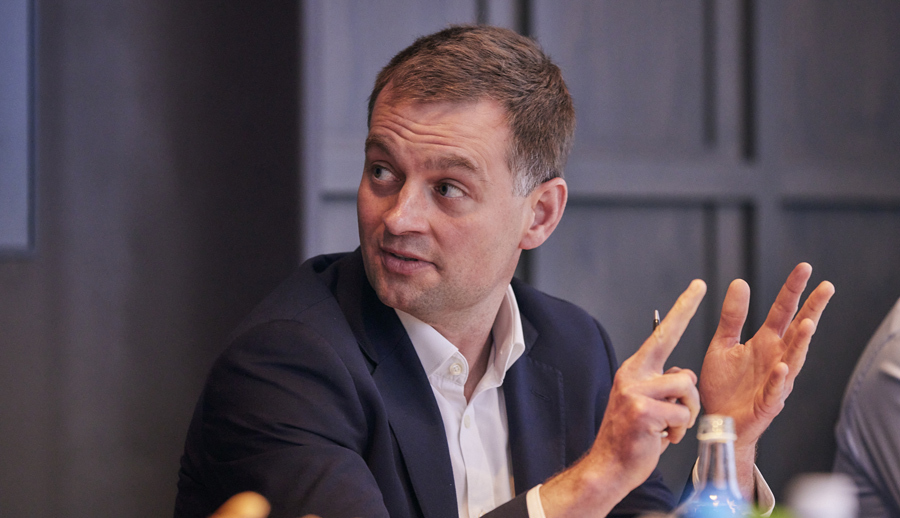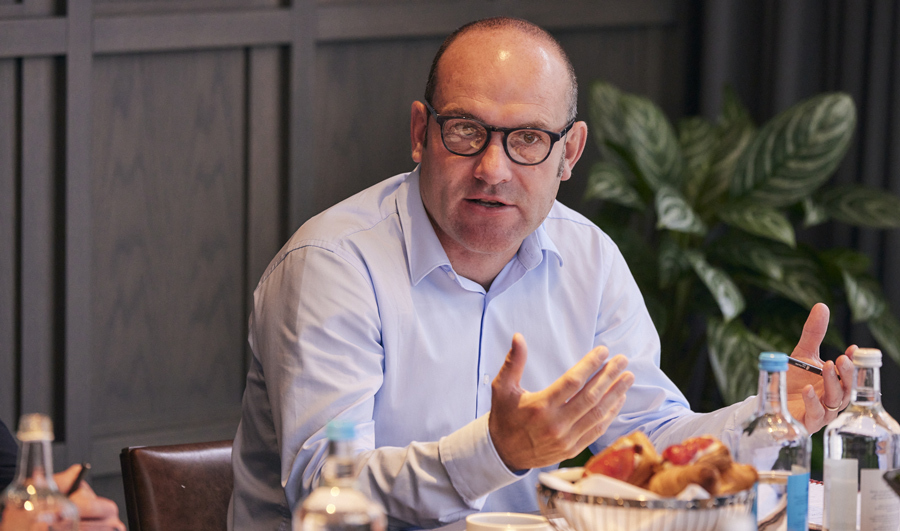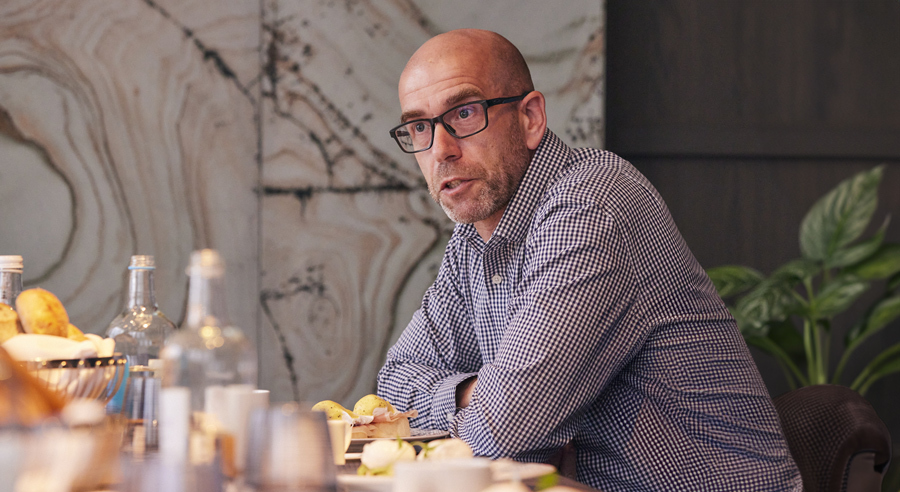
The panellists were (left to right); Andrew Brown, Columbia Threadneedle Investments; James Double, Vidett; Sonia Kataora, Barnett Waddingham; Paul Tremelling, Visa; Jonathan Stapleton, Professional Pensions; Michael Jones, Eversheds Sutherland; Kieron Snow, Phoenix Corporate Investment Services
Professional Pensions assembled a panel of experts to discuss defined contribution (DC) investment strategy.
This roundtable - chaired by PP editor Jonathan Stapleton and held in association with Columbia Threadneedle Investments - looked at the key investment trends in the DC investment space, the extent to which the industry needs to reinvent defaults in the pre-retirement space, and the ongoing implementation of ESG in DC.
What do you see as the key investment trends in the defined contribution (DC) space currently?
Michael Jones: The main one is illiquid assets and potentially increasing the allocation to illiquid assets based around a justifiable investment case. We need to make sure trustees are able to balance cost, value and outcomes and that they feel comfortable in making that decision to invest in illiquid assets, but we are certainly seeing clients look very actively at how they can increase the illiquid allocation in their default strategy.
Aligned to that, we saw quite clearly what happened last year with the gilts crisis. We need to look very closely at the pre‑retirement stage of a lifestyle strategy and make sure it aligns with how the majority of default members take their retirement benefits. There is a bit of a disconnect between what the retirement strategy is targeting in terms of a retirement solution and what members are actually doing - and it is important for us, as supporting fiduciaries, to make sure the default continues to be fit for purpose.
Kieron Snow: Mirroring what Michael was discussing about private markets, we have a number of private market solutions in place and four long-term asset funds (LTAFs) have now been authorised, with others in train. We are speaking to lots of managers who have these in place and are also speaking to lots of consultants, who are waiting to see how this area develops.
The asset flows may be slower to follow - clients have been advised to wait and see what happens next - but there is certainly a lot of discussion going on. I think it is all going in the right direction, but maybe it is just a case of wait and see in terms of the private markets.
In terms of clients themselves, we are seeing a lot of discussion around governance and TCFD reporting taking up a lot of our time.
James Double: Touching on a couple of points, the governance side is a significant point. You have seen over the last few years and continue to see a move from trust‑based DC to DC master trusts, which is probably the way the regulator wants to see things going.
If you look at illiquids, there are challenges, but there is definitely a place for them as part of the default. We have seen in the defined benefit (DB) space that schemes have been caught out with illiquids when they are not able to divest from them - that would be a real challenge in the DC space but as a proportion of a default with significant inflows and outflows, you can manage that. There has to be a space for it.
Andrew Brown: Clearly, the theme from consultants, clients and industry this year certainly seems to be a focus on real assets and harnessing the illiquidity premium that has served DB schemes pretty well for the majority of their existence. I think the economic backdrop is also quite helpful in terms of promoting the case for these types of investments - as they do have a different risk‑return profile to public markets. In an environment where diversification might become more important, real assets probably have a greater role to play.

Indeed, last year was probably one of those years where equities did not perform well and bonds performed particularly poorly - diversifying through public market equities and bonds has not proved that helpful in the short term. Governance bodies are probably looking to ensure their default plans are appropriately diversified to weather different types of storms - and we do seem to be getting different types of storms at the current time, particularly in an environment with high inflation and reasonably high interest rates.
Sonia Kataora: I think the immediate focus is on pre‑retirement strategies, largely because the final quarter of last year has shone light on the design of those strategies.
Ultimately, we are moving into a new investment world. We have enjoyed support from quantitative easing (QE) and easy money over the last decade or so. For DC schemes, we have not had to think that hard in terms of investment design over that period, but we are moving to a new world of quantitative tightening, a new world that requires a different way of investing. We cannot rest on our laurels in terms of the strategies we have had in the past - that means we need to think about how investment risk is spread across members' savings journeys and think about whole‑of‑life investment solutions from when you are a 25-year‑old to when you are 90 years old or more.
Questions that need to be addressed include: how are you taking sufficient risk so the cohort of members that only have DC benefits will retire with adequate savings; how do you distribute that risk between members; and how do you invest in those assets that will give you higher returns for the level of risk? Also, how do you address the sequencing risk and the longevity risk? These are things we are having to think about as we are evolving the strategies. That is married with the long‑term investment horizon - there is, for instance, an acceptance that sustainable investing is a megatrend you cannot avoid because we are investing for that long time frame and DC schemes need to be accepting of these sorts of issues in the design of the investment strategies.
To what extent do you think we need to have a complete rethink of defaults in the pre‑retirement space?
Sonia Kataora: Last year was an interesting one, with inflation hitting 40‑year highs and gilt yields hitting 15‑year highs. Quite frankly, if you wanted to outperform inflation last year, you would have had to have been in quite a risky strategy - either a short strategy or taking huge concentration in certain companies or sectors to outperform inflation. It was a difficult market.
However, this goes back to the question of what is the objective of each phase of the retirement savings journey? In your pre‑retirement phase, we did see schemes that had these long‑duration bonds, which were largely held for historic purposes to shape towards an annuity purchase strategy. Those were the assets that fell by double digits - the ones that were so often described as low‑risk assets - and you had members calling up concerned they had lost 20% of their pot at just the time they were trying to access it.
The solution is about examining the role of the assets at each part of the savings journey. If, for instance, you are going to use some sort of active management or dynamic asset allocation as part of your default strategy, maybe it is the pre-retirement part of the strategy where this will provide better value for the member - the pot is at its biggest size; it is less able to withstand the shocks, and paying a little bit extra for that protection feels like it is better value than when a member is decades away from retirement and can withstand that volatility.
Paul Tremelling: I agree. In our DB scheme, we were protected against interest rate rises. The question is, how can we do that in DC? Given that trustees have put liability-driven investment in place for DB schemes to protect against interest rate rises, is there something we could use as a mechanism for DC schemes?
Sonia Kataora: Exactly. We do want to put those sorts of strategies on at the time you need them - and I would say the time you need them is when you are trying to conserve the capital you have spent decades trying to build up.
James Double: In a way, the lifestyle move towards an annuity purchase is similar to how DB schemes protect against interest rate and inflation risk because they are effectively targeting an annuity for all their members and ultimately, potentially, a buyout. The challenge is that most DC members are not doing that - the majority will now be targetting drawdown or taking their fund as cash at retirement.
Sonia Kataora: Last year also showed that the difficulty in managing the risk of losing purchasing power while also conserving capital - those are two opposing strategies. You can protect against both of them, but can you protect against both of them at the same time?
Michael Jones: As a general point, DC strategies are still dealing with retirement as a point in time, which makes it difficult to mitigate against market volatility. I think the key point is for trustees to get more assurance that their members are accessing benefits in a certain way - and I think that is where the Department for Work and Pensions (DWP) is trying to get to with its decumulation consultation.

If trustees are required to provide access to a preferred decumulation provider that enables them, with more confidence, to invest in different asset types at a later stage of the retirement journey, I think that is the key to mitigating some of the market volatility we have talked about here. The problem is that so many schemes are trying to cater for every eventuality and every retirement option. It is increasingly difficult to design a fit‑for‑purpose suitable default that caters for all retirement options. A bit more targeting of the solution enables trustees with more confidence to invest in different assets.
Kieron, are you seeing any significant movements among DC schemes in the pre‑retirement space?
Kieron Snow: Not at the moment but we are having lots of conversation about decumulation and we are speaking to managers and meeting with consultants.
For me, as well as what you are investing in, it is about how you move people from the accumulation stage into that decumulation stage - is there a smarter way of doing it so you can move people across without breaking that member link?
As a platform, it feels like we may be part of the solution - it feels like we have all of the parts, it is just about how you do it. You cannot do it on an individual basis. It needs to be a collaboration. As I say, I think there is a solution out there, it just needs the industry to put aside some of the traditional competition between various managers, consultants and everyone else and genuinely work as an industry to try to resolve it.
Andrew, you talked earlier about diversifying to weather different investment storms. We have the backdrop of inflation and potentially still rising rates, all of which impact investment strategies more broadly. How can schemes adapt to that changing investment weather, as it were?
Andrew Brown: As mentioned earlier, in the short term there really are not many investments out there that are going to match the current rate of inflation with an appropriate level of risk. It has been said that diversification is the only free lunch in investing. Diversifying through all market conditions can ensure a robust and resilient strategy that does not lose too much money when markets are down, but at the same time will not capture all the upturn when stock markets are rallying. It is that type of asymmetrical return that members should become more accustomed to, reducing the disparity of future outcomes.
When we think about volatility from a member's perspective, we have this notion that members do not like volatility in their pension pots. I think they would accept a disparity in positive returns, for example, if their pot grows by 20% one year and 5% the next. However, I think they would be far more concerned by a material fall in the value of their savings. This can be brought about through an over-exposure to equity markets in particular.
There is no magic bullet here. It really is about diversification and seeking a wide range of return drivers, including real assets, which are less sensitive to the economic climate and reduce correlations with public markets.
Sonia Kataora: Yes, we need diversification, but it cannot be diversification as we have known it. We need to widen the opportunity set for DC schemes to assets we have perhaps not previously invested in, and there needs to be a consideration of real assets, private markets and things that are untethered to public markets. For a DC investor who has the ability to invest over a long timeframe, some of these assets are quite attractively valued.
Looking at the issue from a different perspective, how do you communicate assets falls such as the ones we had last year and at the start of the Covid pandemic?
Paul Tremelling: Last year, with both equities and bond going down, it was difficult. We worked with the trustees to make sure there was no mass exodus and ensure people were not saying they were going to get out of equities and bonds and put it all into cash.
We very much focused on making sure there was no knee‑jerk reaction - and certainly got a communication out within a couple of days of the stock market falling as a result of Covid. We were quite pleased that two or three months later the markets had bounced back and then some.
When communicating more broadly, we put together a newsletter for members and try to give them three or four very short, sharp stories to keep them in the loop. When I give my annual presentations, I remind everyone that they can take cash, go for an annuity or income drawdown, which is like a big bank account. It is trying to put it in simple terms.
Sonia Kataora: Just engaging them on when they expect to retire would probably be a useful thing rather than spending time on investment jargon - it is so significant in terms of when to start that de‑risking process.
Michael Jones: We should focus on clear, transparent and inclusive communications that avoid industry jargon and explain to members a clear sequencing of processes. Check your target retirement date. Check the investment you are in, whether it is the default or not, is fit for purpose. Check your pot size and how it matches your retirement expectations. Check you understand the options available to you. It is almost like a waterfall. But it is difficult to communicate and engage in a meaningful way while meeting all of the governance obligations and disclosing obligations that trustees are subject to, such as the stronger nudge, retirement wake-up, risk warnings, transfer conditions that overlap and at times, duplicate and risk confusing the message to members. It is not easy.
Linking that point back to diversification, do you think there is a reluctance among trustees to diversify into other asset classes because of the lack of engagement from members? Do you think member understanding is one of the barriers?
James Double: Not so much, no. As a trustee, you are designing the best default fund possible. And, actually, the vast majority of people in the default fund are not even looking at it. They are just accepting that this is going to be an appropriate investment for them.
I completely agree with the point about diversification. However, the default fund cannot be overly cautious, especially in a member's early years. We have looked at some default funds that are overly cautious in the early years and question whether the members are really going to get the growth they need in their investment over a 40‑year timespan. You have to accept some risk and volatility.
Michael Jones: I think there is a point around how diversification is being accessed in order to avoid gating or illiquidity issues. Surely the point is that there are ways of accessing diversification through fund of funds structures or blended funds that mean you might not have to be in a situation where you have to do something tangible with that real estate asset because there is sufficient diversification and you are managing the liquidity.
Do we perhaps need to rethink of the structures through which we invest DC assets to make it more flexible for the trustees and managers of those schemes when things like gating happen?
Kieron Snow: Yes, I definitely think so. If something like a property fund is part of a wider fund that is perhaps blended with other liquid funds that are liquid, this can provide the liquidity within the need for gating.
I do think the solution is there and we have created a number of funds to accommodate this. We have, for instance, created a private market solution already for one of our master trust clients - basically creating a blend with a liquid element and an illiquid element. It has its challenges because the illiquid aspect is not daily priced, but we do not see that as an issue; we will price the blend on a daily basis and use the latest price to feed into that.
Sonia Kataora: The important thing with that solution is working through, with the decision‑makers, the liquidity scenario analysis that fits alongside it.
Kieron Snow: There are challenges. But there are lots of levers you can pull - most of these DC schemes, for instance, have got significant asset inflows. You have the liquidity coming in from cashflow. The possibility of gating is significantly reduced if you have the right model in place.

Do you think the restructuring of how default funds work, the operational side of it, is part of the answer to the investment challenge?
Sonia Kataora: What Kieron has described is already in place, but it is not widely used for illiquids and possibly not even for property funds. The infrastructure is there. The LTAF provides another route in, but, equally, you probably will be blending that in with your company white‑label fund. The important part is that the demographics really do work in DC schemes' favour for these sorts of assets. You talked about the inflows. We have seen that on average cash inflows represent about 11% of a scheme's total assets. If you look at outflows, currently in terms of the maturity of schemes, only about 4% is going out, which then rises to about 7% in five years and then possibly 14% in ten years. You can see that DC schemes are net‑positive investors.
We can play out the scenarios and give assurances to the key decision‑makers that the structures are in place, the scenario analysis is in place and the mechanisms are in place to ensure you have the governance that sits around it. That is the important part we are discussing with trustees at the moment.
Andrew, are there other issues at play here as well?
Andrew Brown: Yes, and while these kinds of barriers are not insurmountable, DC investing does seem to be hamstrung by a reluctance to gain exposure to a wider range of asset classes. We were having similar conversations in the industry when I began specialing in DC almost 17 years ago. DC investment governance bodies remain less inclined to cast the investment decision‑making net as wide as their DB counterparts. DB is more of a mathematical equation - it is the employer's balance sheet that is impacted rather than the generally disengaged member, who bears the risk of a poor investment outcome.
It is important to consider the role of master trusts and how they will evolve their investment strategies. Not all are built equally and, while we have a drive towards consolidation, many of these master trusts have been and still are competing on price. When it comes to putting their best thinking into an investment strategy, they are absolutely limited by how much it is going to cost. If a solution is highly constrained by how much it can budget for an investment or an asset class, it is certainly going to disrupt or curtail what you really want to achieve on behalf of members.
When it comes to allocating a meaningful, say, 10% into illiquid assets, if that is going to add another 10% or 15% to the member charge, the master trust is going to be very concerned that it remains competitively priced relative to peers, irrespective of the potential benefit to risk-adjusted returns.
Kieron Snow: I totally agree with what you are saying. Coming from a platform space, we are quite flexible and we can do a lot of innovation, but not everyone wants to pay for it even though this may lead to better overall outcomes for members
Michael Jones: If there is one thing this new value for money framework can do - and I really hope it does - it's move it to net investment return. Immediately, if you start looking at net investment returns rather than costs and charges, you can move the dial to value. Employers will be buying a product on a different set of criteria.
James Double: Value for money started off with a charge cap that served an important purpose. But now trying to get out of a pure focus on charges is critical - the focus on charges is sometimes too high when additional performance can be achieved from accepting marginally higher fees.
Sonia Kataora: In the world of easy money, where all master trusts could be in simple passive strategies, the decision was about who could provide that in the cheapest way.
We are now moving into a new investment world where there are probably fewer places to hide. Master trusts will have to prove their worth, as it were, and the only way you will be able to do that is through the investment design and through the diversification that we spoke about, which comes at a cost. Members can understand this concept of paying more and getting more, but it does require a mindset shift.
Andrew Brown: Communicating and trying to engage members on investment strategy is challeging. Most will not have a frame of reference for understanding the different types of asset classes or what a good return looks like or appreciate a suitable level of volatility. It would be helpful for the industry to agree some rules of thumb and means for measurement. What is good? What is bad? Investing hard-earned savings into an unknown investment outcome is understandably daunting for employees, so they deserve an industry standard benchmark to clearly state whether their provider has performed.
When you are looking into investment strategy, to what extent is cost a factor? Is it a very important part of how you are assessing things?
Paul Tremelling: It is probably music to everyone's ears, but Visa does not mind paying for quality. Yes, it does have a cost, but it is a well-run scheme. It is well governed, well administered and well advised. But you do have to look at the potential cost savings of master trusts, which are huge.

Also, there is the issue of control when it comes to master trust. As a single-employer trust, we can reach out to our own members, we can have the Visa branding exactly how we like it. On behalf of the trustees, I send out the DC pension newsletters. To what extent would that sort of thing stop if a scheme such of ours moved to a master trust?
How is the implementation of ESG in DC investment evolving?
Kieron Snow: All of this work on ESG is very well intentioned, and it is the right thing to do. However, I do think there is a risk of drowning in reporting. We have resources, we have our own sustainability team and we have people who do this as a day job, but I do wonder how single and master trust DC schemes can do this.
There is also the question of who are we writing these reports for. There is a significant amount of work there, especially if we are also talking about TNFD as well as diversity and inclusion - it is all relevant, I'm not saying we shouldn't be doing this, but I think it has to be sensible and consistent to ensure it drives the right outcomes, and doesn't become reporting for reporting sake.
Sonia Kataora: The regulator has already commented on the first round of TCFD reports. They have acknowledged that members are not going to be reading these documents, but I think it is the narrative that is built up over time that will be the key takeaway.
Michael Jones: In my view, TCFD reporting has massively improved the inputs into the governance of schemes. It has made them think, how are they challenging their advisors, how are they challenging their managers, how are they using consultants to act as intermediates to get sufficient coverage and quality of data, what are they doing with this data and how is it flowing into their investment strategy? But I do accept the outputs of this are messy and data gaps flowing into scenario analysis and metrics are producing some undesired and incomplete results.
James Double: It is changing investment managers' behaviours. We have seen it with ESG and stewardship reporting. Investment managers are saying: ‘Yes, we are the leaders in this. We are pushing it. This is what we do.' Managers understand that trustees are now focused on voting and engagement behaviours and if they are not up to scratch, they are at risk of losing mandates.
Andrew Brown: As a fund manager, we have had to evolve our reporting to help trustees meet their regulatory requirements. It is costly, time consuming and involves a great deal of resource. The fact that these do not always get read or put to good use can be quite disheartening.
I think members appreciate stories, rather than a 110‑page TCFD report. Case studies can explain how companies are doing better because pension schemes have exerted their influence. Examples might just engage members.
Kieron Snow: Some ESG reporting does that. We are currently in the process of rolling out member level reporting that breaks it down in simple terms. Equating fund holdings to real life things such as the number of car journeys or plane trips, for example - it tries to equate it to something real and tangible. That sort of thing has been incredibly well received so far by clients - it is not a report of 110 pages; it is an eight‑page summary. It has real things in it and it is something we can actually do at the blended fund level.
Is it fair to say that the sustainability of default funds is improving?
Sonia Kataora: I certainly agree that it is improving. We have seen innovation and you can manage that financial risk and opportunity through active strategies or through passive tilts. Some schemes have done it through exclusions. The regulation was a big help. We are seeing this again now at the moment with the setting of stewardship priorities, which is again trying to move the conversation on even further.
The whole idea is this chain of influence. As asset owners, you should be investing your assets in a way that matters to your members, and you should share that with your asset managers, who can then apply pressure or have that conversation with the underlying investee companies.
Andrew Brown: I also agree that the sustainability of defaults is improving. This has been helped by the government along with regulatory impetus, plus the change in societal beliefs that is contributing towards a change in the investment approach. However, I am conscious that there might be a disconnect between what members think we are doing and what the industry is actually doing in terms of reflecting ESG concerns in their portfolios.
If we think about how we could invest, in terms of the range of sustainable investments. On the left-hand side you have negative screening and then move towards tilted portfolios, and all the way over on the right you have impact strategies or infrastructure projects that can have a much more direct and meaningful approach to tackling climate or social conditions. On the whole, we sit very much to the left of that continuum. Perhaps members would expect us to be further to the right than where we are today, especially given how we communicate to them. The prevalence of ‘tilted' indexed funds is an example. Is it possible to meaningfully engage with thousands of companies?
James Double: The large diversified index‑tracking funds that might have an ESG tilt are going to be a lot cheaper than the actively managed ones. So it comes back to accepting higher charges for a fully ESG-focused actively managed fund.
Sonia Kataora: I do think it is important for trustees and decision‑makers to understand the unintended consequences of investing in some of these funds.
What are your concluding comments and key takeaways following this discussion?
Sonia Kataora: The key takeaway for me is about shifting that mindset from cost to value. It is decisions based on value that will give us the investment strategies we need for the future. And if I can add another point, it would be making this about members - for example, rather than talking about investment risk as volatility, we could talk about changes in projected pot and how that relates to retirement living standards. Changing the language away from investment jargon to the pound amount a member could get helps with the conversation.

James Double: I would love to see illiquids play a larger part. They have been valuable for DB schemes, delivering stable and inflation-protected returns. Saying that, we have to get over the issues around costs. I also have concerns that they can only be a small part of the allocation of a large DC scheme due to issues around liquidity runs on schemes - you can manage that in a large default with big cashflows, but not necessarily in smaller schemes.
Kieron Snow: On the positive side, I think the solutions are out there - between us, we have the solutions. It is the challenge of value versus competing on price that are probably holding the industry back.
In terms of the other piece, the point about decumulation is really important. I am not convinced that we have got it right when members are coming up to pre‑retirement and then going through it. To me, that is such an important area. Again, I think the solutions are out there - it just needs that wider collaboration and discussion, and is something platforms will play a key part in.
Michael Jones: I agree with everything that has been said about moving the dial from cost to value and the alignment between accumulation and decumulation to and through retirement.
I think it is incumbent of me as the lawyer to mention governance. I think we have the inputs, but we do not have the outputs quite right. All we need is two reports - we need one that is telling people what you are going to do, i.e. a statement of investment principles that includes your ESG policy, your climate policy and your voting policy. You then need an output document that reports on what you have done in the form of an ESG report (which expands TCFD to include other ESG factors). We need to be far more strategic, holistic and streamlined about how we are reporting.
Paul Tremelling I agree with Sonia with regards to making this about the members. I am on the Pension and Lifetime Savings Association's DC committee, so I am a big fan of the Retirement Living Standards. For me, it is a good thing to try to explain to members when they ask questions such as ‘how much do I need in retirement?' or ‘am I saving enough?'. I cannot give advice but I can tell people these are the things the need to think about.
Andrew Brown: Ultimately, we are all in agreement that the value framework needs to progress. Without a frame of reference, it is not necessarily for the member themselves to assess whether they are receiving good value but they do need a frame of reference to understand what ‘good' looks like.
In terms of decumulation, we have certainly had more conversations this year than in previous years. I suppose that will develop as more DC savers become increasingly reliant on their DC retirement pots. I think we are in a stage now, with the introduction of pathways and some regulation, whereby we are helping members to avoid catastrophic decisions and the next step should be towards optimising outcomes in postretirement.
Lastly, I think I will lead with what I mentioned earlier. It would be great to see DC investment governance bodies moving towards the kind of DB investment thinking that served DB schemes relatively well for the past 20 years or so, ie investing in a wider range of asset classes, not looking solely at costs and taking advantage of some of the opportunities that will help members achieve good outcomes.
This roundtable was held on 20 June in association with Columbia Threadneedle Investments







